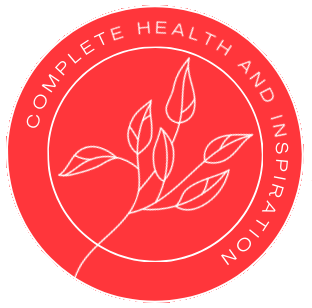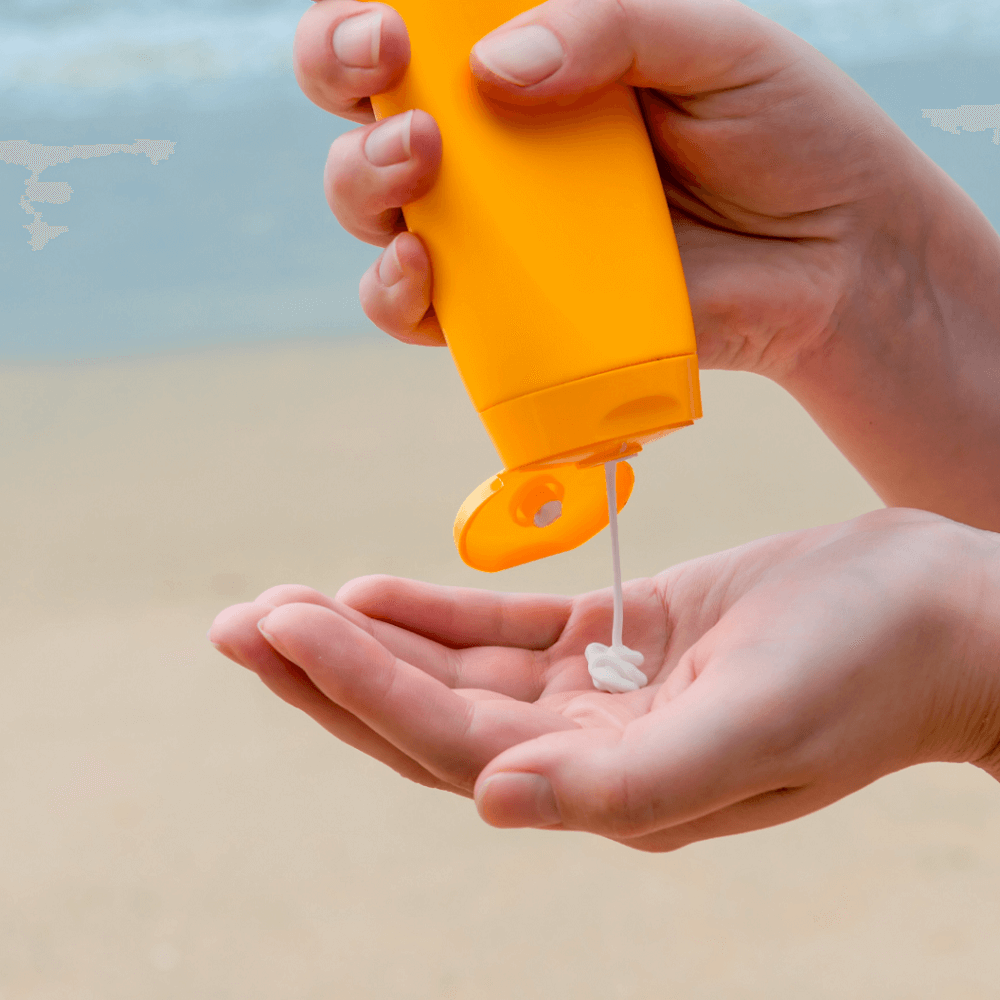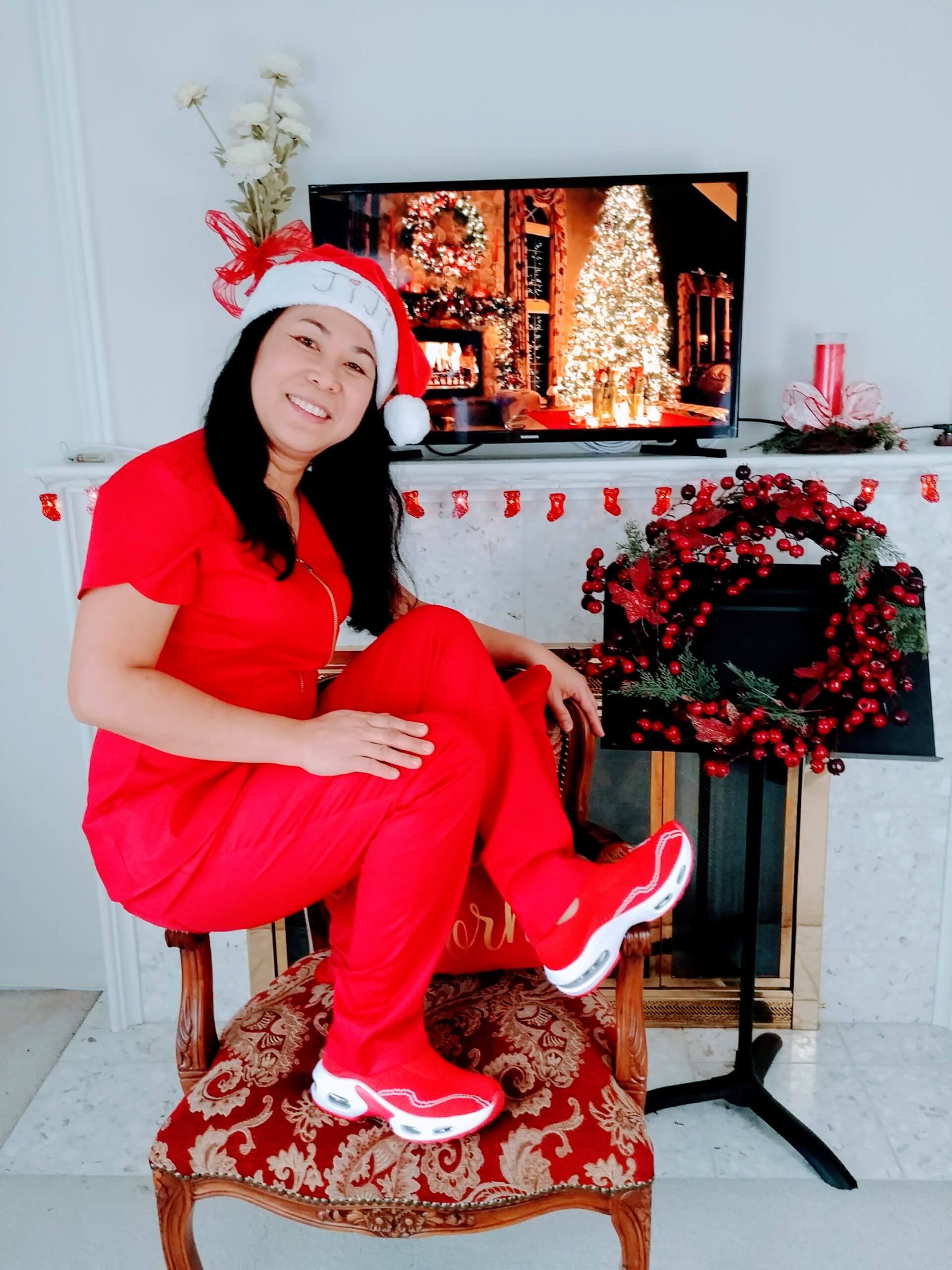We have the most beautiful summer this year as far as I could remember. We have been enjoying the rain with the sun and our strawberries are really giving us good harvest compared to last year. This only means though that we have to spend more time under the sun to gather all our produce. That being said I started researching ways to protect ourselves from being scorched under the heat.
What’s the difference between UVA and UVB?
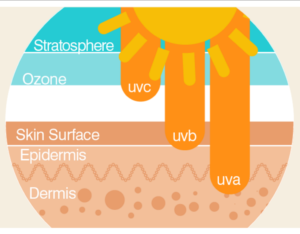
COOLA
I thought COOLA’s infographic above gives a good understanding of how the rays of the sun penetrate our skin. In its Sun Science page COOLA mentioned that the sunlight is made up of two harmful rays: the long wave ultra violet A (UVA) rays which penetrate deep into the dermis, the thickest layer of the skin; and the short wave ultra violet B (UVB) rays which usually burn the superficial layers of the skin.
Let’s get a better understanding of UVA and UVB as explained by Jennifer Zhao, Lead Material Science Engineer, in her article posted in GE Global Research. She said that both UV rays contribute to premature aging of skin and can cause skin cancer because of their ability to damage skin cells and alter their DNA. She further enumerated their differences below:
- Long Wave Ultra Violet A (UVA)
- It is an ultraviolet radiation between 400-320 nm (nanometer) wavelength. (A nanometer is about 100 thousand times smaller than human hair.)
- It accounts for 90 to 95% of UV radiation that reaches the earth.
- It is present equally throughout the daylight hours and throughout the seasons, and can penetrate cloud and glass.
- It penetrates deeper layers of skin and causes tanning.
- Short Wave Ultra Violet B (UVB)
- It is between 320-290 nm wavelength. The shorter the wavelength, the higher the energy of radiation.
- It makes up only 5-10% of solar radiation.
- Its high energy damages surface epidermal layers and causes sunburn.
- It is strongest between 10 AM and 4 PM, from April to October and do not significantly penetrate glass.
Whats the Difference Between Sunblock and Sunscreen?
Now that we know what we need to protect ourselves from, let us find out what we can protect ourselves with from the heat of the sun. Dr. Kenneth A. Arndt, MD, clinical professor of Dermatology at Harvard Medical School, Boston, wrote in the “Bottom Line Personal” that sunblock and sunscreen are not the same. He pointed out how they are different below:
- Sunblock(s)
- They are opaque and block almost all of the sun’s UVA and UVB rays.
- They consist largely of zinc oxide and titanium dioxide.
- They do not have to be reapplied every few hours.
- Sunscreen(s)
- They are less visible on the skin and are designed to protect against UVA, UVB, or both.
- They do allow some radiation through.
- They need to be reapplied every few hours because their ingredients break down after exposure to sunlight. If you use sunscreen, it is better to use one that has a high SPF, put on a lot, and reapply every two to three hours.
Further readings about this topic led me to discover that sunblock is also called physical block or mineral sunscreen and sunscreen is synonymous with chemical block or classic sunscreen. Let us summarize our findings below with recommendations from Dr. Shawn Allen, MD, Boulder Dermatologist:
Sunblock/Physical Block/Mineral Sunscreen
- The better physical blocks are zinc oxide and titanium dioxide with zinc being superior in broad spectrum protection.
- These physical blocks reflect and scatter light and act as a mirror on your skin to block entry of UV into the skin.
- Look for SPF 30, which will block 97% UV rays.
- Also look for zinc oxide in greater than 3% to provide coverage of UVA light and better overall protection.
Sunscreen/Chemical Block/Classic Sunscreen
- Chemical sunscreens are often unstable after exposure to UV light and degrade over time.
- Some of the better spectrum coverage ingredients include Avobenzone (Parsol 1789) and mexoryl / helioplex / ecamsule.
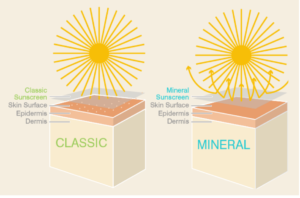
COOLA
What is SPF?
Though both medical doctors used different terms for sunblock and sunscreen, both recommended to look for one that has a high SPF. Consumer Reports Magazine wrote that SPF or Sun Protection Factor is a relative measure of how long a sunscreen will protect you from ultraviolet (UV) B rays. It further explained that:
“The chief cause of reddening and sunburn, UVB rays tend to damage the epidermis, skin’s outer layers, where the most common (and least dangerous) forms of skin cancer occur. Those cancers are linked to sun-accumulation over the years. Another type of skin cancer, melanoma, is thought to be caused by brief, intense exposures, such as a blistering sunburn.
Assuming you use it correctly, if you’d burn after 20 minutes in the sun, an SPF 30 sunscreen protects for about 10 hours. But intensity and wavelength distribution of UVB rays vary throughout the day and by location. And that calculation does not apply to UVA rays.
UVA rays are long enough to reach skin’s dermal layer, damaging collagen and elastic tissue. That layer is also where the cells that stimulate skin darkening are found; that’s why UVA rays are considered the dominant tanning rays. (UVA rays are also used in tanning beds.) Though many people still think a tan looks healthy, it’s actually a sign of DNA damage—the skin darkens in an imperfect attempt to prevent the further injury, which can lead to the cell mutations that trigger skin cancer.”
Perhaps the screenshot summary below will give more insight on how UVB Protection and UVA Protection are measured:
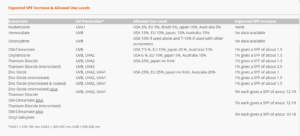
Making Cosmetics
Just when you figured out how you can get a nice way to do sunbathing, when you thought you finally found the right product that will give you the most protection from the sun’s heat, you found out that no sunscreen blocks 100% of UVB rays and ultrahigh SPFs are not much more protective than SPFs of 30 or 50. It is erroneous to assume that SPF 30 is twice as effective as SPF 15. To get the most protection, you would like to get a broad spectrum sunscreen that protects against UVB and UVA rays.
- SPF 15 blocks about 93% of UVB rays,
- SPF 30 blocks 97%,
- SPF 50 blocks 98%, and
- SPF 100+ blocks about 99%.
A screenshot below shows the different sunscreen ingredients with their equal UV protection from MakingCosmetics:
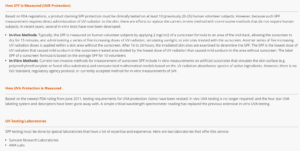
Making Cosmetics
According to Environmental Working Group (EWG) most chemical sunscreens include a combination of three to six of the following as active ingredients: oxybenzone, avobenzone, octisalate, octocrylene, homosalate and octinoxate. Among these ingredients oxybenzone is said to be added to nearly 70 percent of the non-mineral sunscreens in EWG’s 2016 sunscreen database. EWG recommends that consumers avoid oxybenzone for the following reasons:
“The Centers for Disease Control and Prevention has detected oxybenzone in more than 96 percent of the American population, based on a representative sampling of children and adults (Calafat 2008). Participants who reported using sunscreen have higher oxybenzone exposures (Zamoiski 2015). Oxybenzone can cause allergic skin reactions and may disrupt hormones (Rodriguez 2006, Krause 2012).
Americans’ exposures to oxybenzone appear to be increasing over the past decade, based on analysis of CDC’s multi-year NHANES study (Han 2012). Investigators at UC Berkeley recently reported a dramatic drop in teen girls’ exposure to oxybenzone and other ingredients of concern in cosmetics when they switched from their usual products to replacements that did not contain those chemicals (Harley 2016).”
However, the Journal of American Medical Association (JAMA) Network in an article, Safety of Oxybenzone: Putting Numbers Into Perspective, published in July 1, 2011, came to this conclusion:
“Our results indicate that both the application regimens and time periods required to obtain systemic levels of oxybenzone equivalent per unit of body mass are essentially unattainable. Our assumption is more conservative. For instance, the bioavailability of the oxybenzone-containing rat chow used by Schlumpf et al10 may not have been 100%, and we did not take into account the excretion of oxybenzone in humans. In fact, oxybenzone has not been demonstrated to accumulate in the plasma even after several days of topical application.6,9,18 Most relevant to this discussion, however, is that in a human study, oxybenzone did not demonstrate significant endocrine disruption, even with application of a formulation containing 10% oxybenzone.6 In fact, after 40 years of use, we are not aware of any published study that demonstrates acute toxic effects in humans with systemic absorption of oxybenzone.”
Homemade Or Store Bought Sun Protection
The debate going on about what is safe and what should be avoided for sunscreen ingredients is enough reason to venture on making your own homemade sunscreen. However, even this idea posts a risk. For one, the SPF rating that one assumes he gets for his formula may not be the real rating when it gets tested in a laboratory.
Another reason pointed out by a Professional Cosmetic Chemist, Amanda Foxon-Hill, in The Trouble With Making Your Own Sunscreen is that zinc oxide (the common ingredient for DIY sunblock) tends to stick together. She had her share of difficulties on her own effort to formulate a perfect sunscreen and has this to say:
“One thing that I realized early on was that just because you put zinc in, it doesn’t mean that it stays sitting in the formula in a useful place. A good sunscreen has to cover the skin evenly like a good coat of paint and unfortunately for zinc users, that chemical prefers to clump together giving you dense lumpy areas that you may or may not be able to see with the naked eye and then empty wasteland craters all of which can act as lenses for sunlight and actually magnify the rays as they come through.”
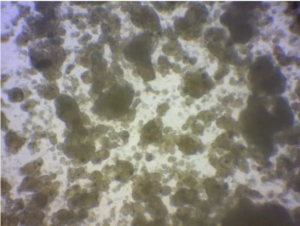
RealizeBeautyEd
Stay Well-Hydrated
After gathering all these information I couldn’t help but think of other ways to avoid getting sunburn. Getting well-hydrated during hot season is one key factor to ensure that our skin stays hydrated as well to replenish the water loss with sweating, especially during active workout. How much water to drink depends on our size and weight, state of health, activity level and the place where we are or where we live.
A good rule of thumb is to drink half an ounce to an ounce of water for each pound you weigh everyday. For example, if you weigh 120 pounds you need to drink about 60 to 120 ounces of water daily. To get how many glasses of water you need, calculate 60 (ounces) x 30 (milliliter) = 1,800 (milliliters) divided by 240 (milliliters) = 7.5 glasses per day. (1 ounce approximately equals to 30 milliliters, and 1 glass approximately equals to 240 milliliters). So a 120-ounce is about 15 glasses of water consumption.
This is a conservative way of getting the ideal hydration our body needs. Pregnant and nursing women need to increase their water intake, as well as for people who live in hot climate areas and moving about or exercising a lot. People with heart condition or on dialysis however, may need to restrict their water intake as prescribed by their doctors and need to avoid situations that promote more water loss from the body. Those who live in cooler climate and are mostly sedentary may need less water intake but still need to make sure they get their daily water requirement.
Personally
During those times when we have to stay under the sun, like strawberry-picking, I prefer to put on my homemade skin moisturizer with 12% zinc oxide. I don’t want to call it a sunblock or sunscreen, nor want to claim any SPF rating for it because it’s not laboratory tested. However, I know all the ingredients it is made of and feel comfortable of its protection. I put on my wide brim hat and comfortable shoes, keep my extremities covered and have a towel on my back under my clothing.
When we have to go to the beach, I would still apply my homemade skin moisturizer and stay under a shade during peak hours. I wont hesitate to apply over a layer of store-bought sunscreen (when I find the ingredients acceptable) before staying under the sun or going for a swim, and reapply it every 2 to 3 hours when needed.
Conclusion
It is evident that sunblock or sunscreen should just be one of the sun protection strategies to use to protect our skin. We can cover up with clothing, put on a hat, seek a shade, and try to stay out of the sun during peak hours between 10:00 am to 4:00 pm. A good pair of sun glasses with UV protection keep our eyes safe and could make staying outdoors more enjoyable without having to squint from the glaring sun. We can also make sure we have enough water to keep us hydrated during hot season, drink adequate amounts daily and make it a habit to drink regularly throughout the day – not only when thirst comes.
Extra measures need to be observed when protecting kids, especially babies, and elderly people from the sun’s heat, because they are more prone to getting sunburn when exposed under the sun for long periods. They may need extra layer of clothing for cover and be provided a shade where they can get away from the harsh sun especially during peak hours. It is also wise to keep an aloe vera gel handy in the event of getting sunburn for immediate application. It cools off the skin and is soothing to the burning sensation on the affected part.
The American Academy of Dermatology has more information on how to be adequately protected from the harsh elements of the sun. Whether you prefer a homemade or store-bought sunblock or sunscreen is a matter of personal choice. It is important to make a decision based on your health needs and what is available on hand. It is best, however, to be adequately prepared before exposing yourself under the sun. Get your dose of vitamin D and enjoy summer, armed with the essential protection to get a healthy tan without the sunburn.
